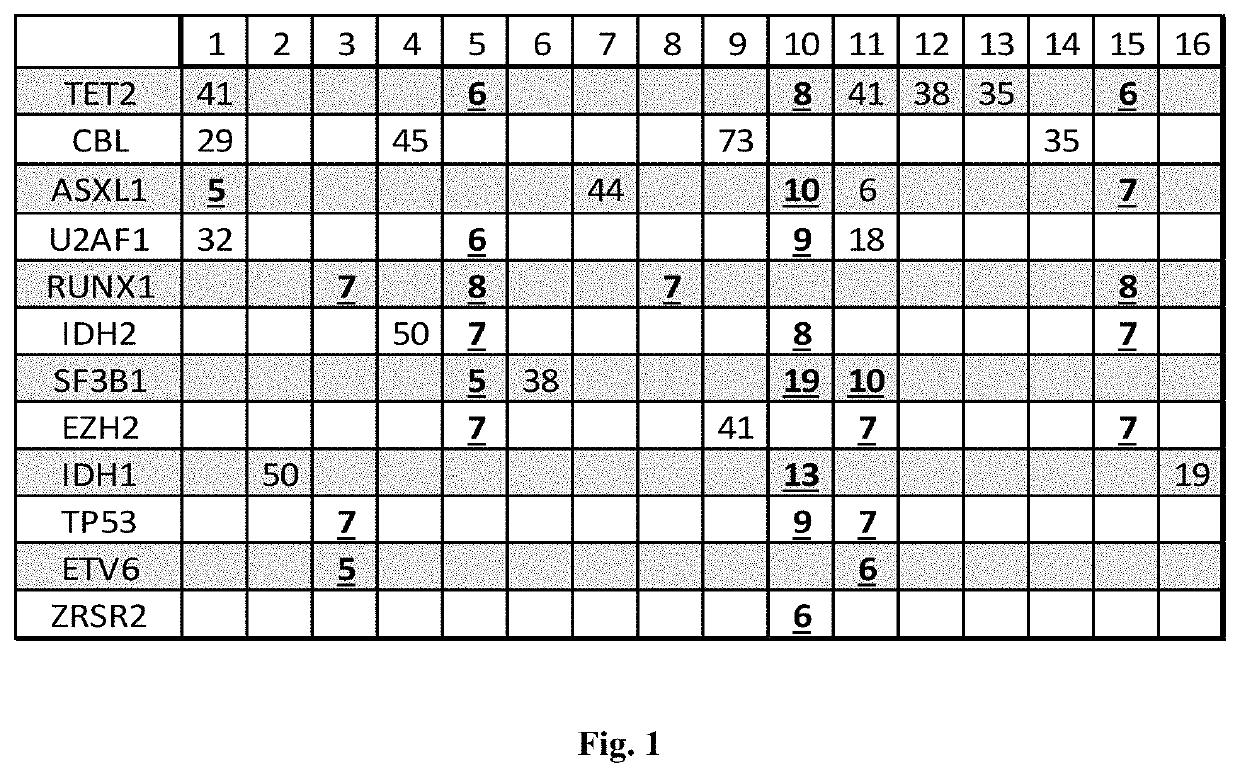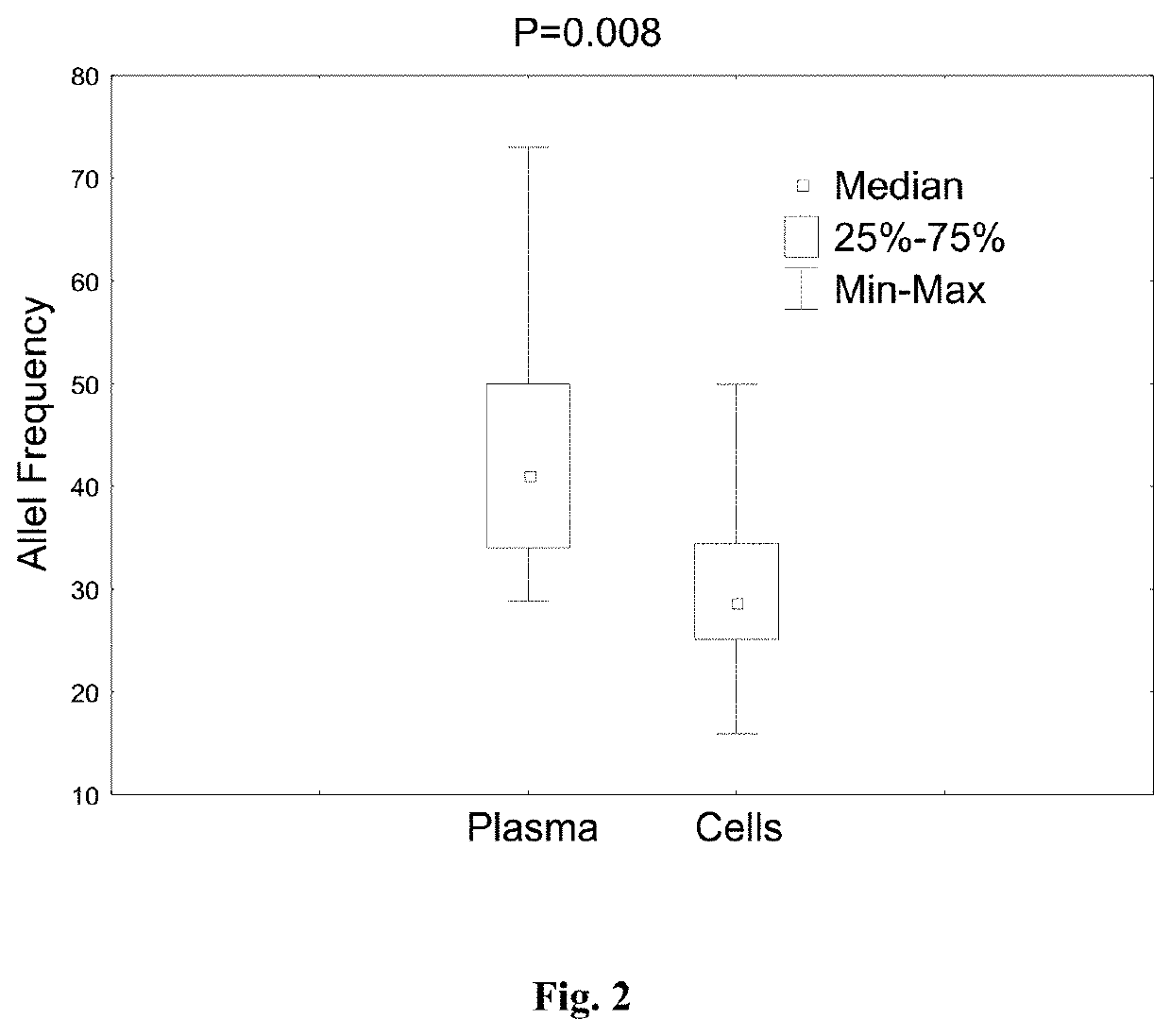Deep sequecing of peripheral blood plasma DNA as a reliable test for confirming the diagnosis of myelodysplastic syndrome
a peripheral blood and plasma dna technology, applied in the field of deep sequecing of peripheral blood plasma dna as a reliable test for confirming the can solve the problems of difficult diagnosis of myelodysplastic syndrome, severe infectious diseases, anemia or hemorrhage caused by dysfunction and blood cell reduction, and achieve the effect of increasing bone marrow blasts
- Summary
- Abstract
- Description
- Claims
- Application Information
AI Technical Summary
Benefits of technology
Problems solved by technology
Method used
Image
Examples
example 1
and Samples
[0069]Peripheral blood (PB) samples were collected from 16 patients confirmed to have MDS by bone marrow evaluation and from four age-matched normal controls. All patients had blasts <5%.
[0070]Cell-free DNA from peripheral blood plasma and cellular DNA from PB cells was extracted. The characteristics of the patients are listed in Table 2.
[0071]
TABLE 2Patient PopulationNumberCytogeneticsDiploid13del (6)(q21)1Trisomy 81Complex1GenderFemale7Male9MedianRangeWBC3.52.0-16.4HGB10.59.6-12.6MCV102.891-106Platelets10374-194% Lymph26.914.3-52.4 % Monocytes9.16.3-19.9% Polys59.737-77 Age7353-92
example 2
tion
[0072]Total nucleic acid was isolated from plasma using a NucliSens extraction kit (BioMerieux Inc., Durham, N.C.) according to the manufacturer's instructions. DNA from PB cells was isolated using a QIAamp DNA Blood Mini Kit (Qiagen, Valencia, Calif.) according to the manufacturer's instructions.
example 3
uencing
[0073]Using Sanger sequencing and NGS, mutations were analyzed in the following genes: ASXL1, ETV6, EZH2, IDH1, IDH2, NRAS, CBL, RUNX1, SF3B1, SRSF2, TET2, TP53, U2AF1, and ZRSR2. Sanger sequencing was performed using a standard protocol. The primer pairs were designed to encompass >90% of reported mutations in these genes. Polymerase chain reaction (PCR) products were purified and sequenced in both forward and reverse directions using an ABI PRISM 3730XL Genetic Analyzer (Applied Biosystems, Foster City, Calif.). Sequencing data were base-called using sequencing analysis software and assembled and analyzed with SeqScape software (Applied Biosystems).
[0074]NGS was performed using the Illumina MiSeq system (San Diego, Calif.); NGS, amplification, and indexing were performed as recommended by the manufacturer. Amplicons were confirmed for each sample by running an agarose gel. Samples were pooled and the experiment sheet was generated using Illumina Experiment Manager. MiSeq Re...
PUM
| Property | Measurement | Unit |
|---|---|---|
| allelic frequency | aaaaa | aaaaa |
| length | aaaaa | aaaaa |
| electrophoretic gel | aaaaa | aaaaa |
Abstract
Description
Claims
Application Information
 Login to View More
Login to View More - R&D
- Intellectual Property
- Life Sciences
- Materials
- Tech Scout
- Unparalleled Data Quality
- Higher Quality Content
- 60% Fewer Hallucinations
Browse by: Latest US Patents, China's latest patents, Technical Efficacy Thesaurus, Application Domain, Technology Topic, Popular Technical Reports.
© 2025 PatSnap. All rights reserved.Legal|Privacy policy|Modern Slavery Act Transparency Statement|Sitemap|About US| Contact US: help@patsnap.com


